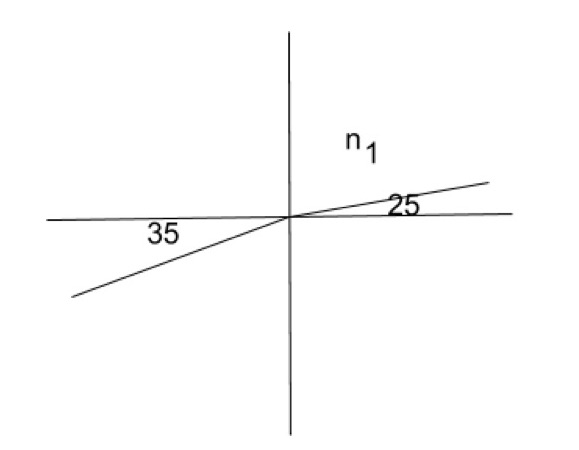Optics, Waves, and Quantum
Help Questions
SAT › Optics, Waves, and Quantum

Light passes from a medium with some index of refraction 

Explanation
Snell's law states:
If we substitute the values from the question we get:
Next rearrange to isolate
Which of the following scenarios would result in the polarization of light?
Light is reflected off of a glass window
Light pass between two mediums with the same index of refraction
Light passes through a vacuum
Light is absorbed by a black body
A light source travels at a high velocity
Explanation
Light is polarized when it is all oscillating in the same direction. This effect occurs when light is reflected. Polarization can occur through refraction, however if light is passing between mediums with the same index of refraction, the light will not refract.

Light passes from a medium with some index of refraction 

Explanation
Snell's law states:
If we substitute the values from the question we get:
Next rearrange to isolate
Which of the following scenarios would result in the polarization of light?
Light is reflected off of a glass window
Light pass between two mediums with the same index of refraction
Light passes through a vacuum
Light is absorbed by a black body
A light source travels at a high velocity
Explanation
Light is polarized when it is all oscillating in the same direction. This effect occurs when light is reflected. Polarization can occur through refraction, however if light is passing between mediums with the same index of refraction, the light will not refract.

Light passes from a medium with some index of refraction 

Explanation
Snell's law states:
If we substitute the values from the question we get:
Next rearrange to isolate
Which of the following scenarios would result in the polarization of light?
Light is reflected off of a glass window
Light pass between two mediums with the same index of refraction
Light passes through a vacuum
Light is absorbed by a black body
A light source travels at a high velocity
Explanation
Light is polarized when it is all oscillating in the same direction. This effect occurs when light is reflected. Polarization can occur through refraction, however if light is passing between mediums with the same index of refraction, the light will not refract.
A dog is stationary in someone's front yard and barks at a frequency of 

The observer is moving towards the dog
The observer is moving away from the dog
Both the dog and the observer have the same acceleration
Both the dog and the observer have the same velocity
The observer is traveling in circular path with the dog at the center of the circle
Explanation
The doppler effect states that the observed frequency depends on the frequency produced, and the relative velocities of the observer and sound source:
To increase the observed frequency the sound source and the observer must be moving towards each other. Since the dog is stationary, therefore the observer must be moving towards the dog.
A dog is stationary in someone's front yard and barks at a frequency of 

The observer is moving towards the dog
The observer is moving away from the dog
Both the dog and the observer have the same acceleration
Both the dog and the observer have the same velocity
The observer is traveling in circular path with the dog at the center of the circle
Explanation
The doppler effect states that the observed frequency depends on the frequency produced, and the relative velocities of the observer and sound source:
To increase the observed frequency the sound source and the observer must be moving towards each other. Since the dog is stationary, therefore the observer must be moving towards the dog.
A dog is stationary in someone's front yard and barks at a frequency of 

The observer is moving towards the dog
The observer is moving away from the dog
Both the dog and the observer have the same acceleration
Both the dog and the observer have the same velocity
The observer is traveling in circular path with the dog at the center of the circle
Explanation
The doppler effect states that the observed frequency depends on the frequency produced, and the relative velocities of the observer and sound source:
To increase the observed frequency the sound source and the observer must be moving towards each other. Since the dog is stationary, therefore the observer must be moving towards the dog.
Of the following, which type of waves has the longest wavelength?
Microwaves
Green light
Orange light
Gamma rays
X-rays
Explanation
Wavelength and frequency have an inverse relationship; as one value increases, the other value decreases. In contrast, frequency and wave energy have a direct relationship; as one term increases, the other increases as well.
In the electromagnetic spectrum all wave types have the same velocity, but some have greater energy (and frequency) than others. Gamma rays have the highest energy, while radio waves have the lowest. In order from lowest energy to highest, the types of electromagnetic waves are radio waves, microwaves, infrared light, visible light, ultraviolet light, X-rays, and gamma rays.
Of the given answer options, microwaves have the lowest energy. This means they will also have the lowest frequency, and largest wavelength.









